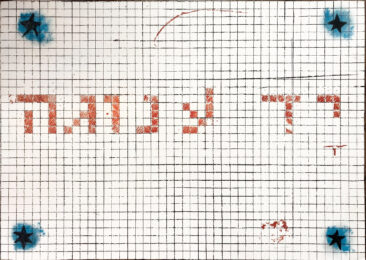

Moshe Gershuni, Israeli, 1936-2017.
Moshe Gershuni was born in Tel Aviv. In his work, particularly in the 1980s, he expressed a point of view that diverged from the establishment position, especially with regard to Jewish sources, homo-eroticism and remembrance of the Holocaust. He was declared the winner of the Israel Prize for painting in 2003, but in the end was disqualified from receiving it.
In the 1970s, Gershuni created sculptures and installations influenced by the minimalistic and conceptual art then popular in the United States and Europe. Other works touched upon political issues and dealt with bodily functions.
In the 1980s, Gershuni changed his style, incorporating a mixture of texts from Jewish sources, references to the Holocaust, and references to Zionism (mostly military), along with homo-erotic personal references. He combined an expressive use of color with scribbles, paint drips, paint smeared by his fingers, and quotations from poetry and prayer.
Among his well-known works from this period are “Hai Cyclamen” (1984), a series of prints, “Kaddish” (1984), and a series of paintings, “In the Mirror and in Riddles” (1986).
In the 1990s images from the iconography of death, such as funeral wreaths or images of eyes, began to appear in his paintings. His late works include abstract expressive paintings which use thick layers of paint in an attempt, in Gershuni’s words, to produce a “transparent screen of shadows that come from the black place.”